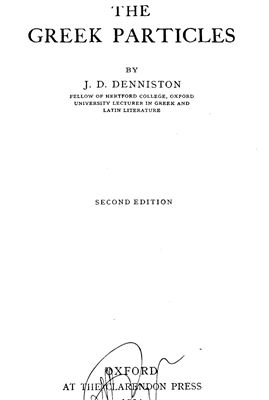Oxford University Press, 1954. - 333 p.
This revised edition incorporates additional examples from the original author in conjunction with K.J. Dover's own material. In presenting the first (1934) edition, Denniston set himself to cut down the etymological discussion which characterised his German predecessors in the field. He was conceed to illustrate how particles work and how they nuance Greek language within the corpus of surviving work. His primary aim was "literary, not grammatical or etymological". With this in mind he regarded exemplification as the key, citing much more than his predecessors in the belief that "the reader should be enabled to bathe in examples". When Denniston died (1949) he left copious notes - additional examples, changes of mind in the light of fresh material; these were incorporated by K.J. Dover in the second edition (1950) with new material of his own and the addition of indexes.
This revised edition incorporates additional examples from the original author in conjunction with K.J. Dover's own material. In presenting the first (1934) edition, Denniston set himself to cut down the etymological discussion which characterised his German predecessors in the field. He was conceed to illustrate how particles work and how they nuance Greek language within the corpus of surviving work. His primary aim was "literary, not grammatical or etymological". With this in mind he regarded exemplification as the key, citing much more than his predecessors in the belief that "the reader should be enabled to bathe in examples". When Denniston died (1949) he left copious notes - additional examples, changes of mind in the light of fresh material; these were incorporated by K.J. Dover in the second edition (1950) with new material of his own and the addition of indexes.

